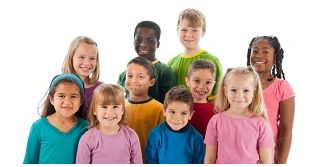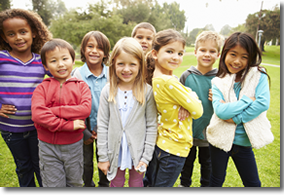The Issue of Child-on-Child Sexual Abuse
Consultant to the VIRTUS® Programs

The children are too quiet. Something is up. When you go to investigate, you find two six-year-olds minus parts of their clothing playing "doctor." Or, you might overhear a conversation between two four-year-olds repeating "bathroom" words as they giggle hysterically. Or you might notice that two-year-old Timmy constantly walks around with his hands in his shorts. While each of these situations is different, they are similar in that the children are all involved in various forms of normal sexual exploration. Let’s be honest, observing elements of sexuality in children's play often causes parents and caregivers to feel uncomfortable. On one hand, developmental experts tell us that it is normal for children to act this way at certain ages, that the sexual play of young children usually results from their need to explore everything, and is also a way to indicate to the adults around them that they would like more information on the topic. On the other hand, we worry about whether the behavior of the children is, indeed, normal and how we should respond to it. Could the children's behavior be an indication of (or actually be) sexual abuse? How do you tell the difference? How do you talk about it with children?
First, it is important to distinguish between age appropriate and age inappropriate sexual behaviors. Many children engage in sexual behaviors and show sexual interests throughout their entire childhood, even though they have not yet reached puberty. However, normative (or expected) sexual behaviors are usually not overtly sexual, are more exploratory and playful in nature, do not show a preoccupation with sexual interactions, and are not hostile, aggressive, or hurtful to the child or to others. Conversely, these behaviors of childhood and adolescence are of concern when they are extensive or suggest preoccupation, or involve others in ways that are not consensual. That is, sexual behaviors in children present a special concern when they appear as prominent features in a child's life, or when sexual play or behaviors are not welcomed by other the children involved in the play. This is the point where “play” crosses the line into sexually harmful and aggressive behaviors.
Often, the types of behaviors that “cross the line” can be warning signs that a child has been exposed to, or had contact with, inappropriate sexual activities or material—particularly if the child expresses or demonstrates knowledge of sexual activity that is normally beyond the understanding of children his or her age. The child may engage in a variety of age-inappropriate sexual behaviors as a reaction to his or her own exposure to sexual experiences. The child may begin to act out, or engage in, sexual behaviors or relationships that include excessive sexual play, inappropriate sexual comments or gestures, mutual sexual activity with other children, or sexual molestation and abuse of other children. Obviously, professional clinical and investigative help are required in these circumstances.
So what’s a parent to do? It is a parent’s worst nightmare to even think about his or her child being sexually abused. Because it is uncomfortable to talk about sexual issues, and to think of our children as sexual beings created and loved by God, as all of us are, we fall into the trap that every child sexual molester wants us to—one of denial. We need to talk with our children about these issues, not to instill fear, but to give them clear information and instruction about how to stay safe, and to ensure that they know the language to use and to understand that they have permission to come talk to us should anything happen. But how? Thankfully, just as there are five clearly identified steps in the Protecting God’s Children® program for adults that build awareness of the issues of child sexual abuse and consolidate practical advice about prevention and building safe environments, there is a set of evidence based practices and guidelines that parents, teachers, and others can use in talking with children about personal safety and teaching them the skills necessary to keep them safe from sexual exploitation.
One of the most effective ways to talk about abuse prevention with children is to do so within the context of general safety. Parents teach their children to look both ways when crossing the street, to wear their seat belt in a vehicle, to ask permission before going out to play, and to not talk to strangers. In the same way, parents can talk with their children about safe, unsafe, and unwanted touches—explaining that although most touches are safe, their bodies also have private parts, and that it is not safe for others to touch or look at these parts except under very limited circumstances like bathing and doctor visits. Most experts suggest that parents should begin to teach their children about body safety between the ages of 3-5. This includes:
- The accurate names of private body parts or, for younger children, the ability to recognize that private body parts are the parts covered by the bathing suit,
- Rule-based instructions regarding what to do if anyone, even another child, touches them (or asks them to touch) in a way that is unsafe or harmful (Say “No!”, get away, tell a grown up),
- Assurances that they (children) get to say whether a touch is “unwanted” or not,
- Reminders that they can always talk to you (or another trusted adult) about anything, and should tell you right away if anyone attempts to look at or touch their private parts,
- That they should continue to tell about harmful, unwanted, unsafe, scary, or confusing touches until they are believed,
- Reassurance that you will listen to them, believe them, and keep them protected, and,
- That abuse is never their fault.
Remember to review this information and to practice it on a regular basis. This is not a one-time conversation; it will necessarily evolve and expand into other areas as the children mature. Take advantage of “natural teaching moments” to talk to the children about personal safety during bath time as you are teaching your child to wash him or herself; at bed time when they are focused on what you are saying; or before going to camp, starting school, or going to day care. Play "what if" games with your children and let them practice saying "No!" assertively. By role-playing with your children, you help them develop the skills they need in potentially harmful situations. Later, as the children begin to spend more time away from home with friends, at the mall, babysitting, and eventually dating, the conversations about safety will go beyond a simple rule-based approach to include issues of power, peer pressure, harassment, and Internet safety—issues more in line with their developmental stage. Sex abuse prevention education is “preventive” in nature. It is not intended to educate children about sex, sexuality, the sexual functions of private parts, or human love relationships. It is intended to teach children about their rights to assert limits over what happens to their bodies and to give them the tools necessary to communicate effectively if someone, even another child, violates those boundaries. At the same time, it also teaches them awareness of and respect for other people’s boundaries. In short, talking with your children about personal safety and sex abuse prevention shows them that the lines of communication with you are always open, and teaches them how to prevent themselves from being victimized—by anyone.
REFERENCES
“Curiosity or cause for concern: Sexuality in early childhood play”, Sauzier, M., Beginnings, 36-38. (Spring, 1984).
“Child Sexual Behaviors: What Is Considered ‘Normal’ Sexual Development and Behavior?” Rich, P. Understanding, Assessing, and Rehabilitating Juvenile Sexual Offenders, (2002, revised 2008).
“Do Children Sexually Abuse Other Children? Preventing Sexual Abuse Among Children and Youth”, Stop It Now! (www.stopitnow.org), Brochure, (2007).
“From Diapers to Dating: A Parent's Guide to Raising Sexually Healthy Children”, Haffner, Debra W., New York: Newmarket Press. (2000).
“Juveniles Who Have Sexually Offended, a Review of the Professional Literature”, Righthand, S. & Welsh, C., Office of Juvenile Justice and Delinquency Prevention, Washington, D.C., U.S. Department of Justice. (March 2001).
“Keys to Your Child's Healthy Sexuality”, De Freitas, Chrystal, Hauppauge, NY: Barrons Educational Series. (1998).
“Sexually Aggressive Children”, Araji, Sharon K. Thousand Oaks, CA: Sage Publications. (1997).
“Talking About Touching®, A Personal Safety Curriculum”, Committee for Children, Seattle, WA. (2010).
“Teaching Touching Safety™”, The National Catholic Risk Retention Group, Inc., Lisle, IL.
“Treating Child Sex Offenders and Victims”, Salter, Anna C. Newbury Park, CA: Sage Publications. (1988).
“Understanding Your Child's Sexual Behavior”, Cavanaugh Johnson, T, Oakland, CA: New Harbinger Publications. (1999).
“Victims of Violent Juvenile Crime”, Office of Juvenile Justice and Delinquency Prevention. (2004).
This article is not part of your continuing training. To access your required bulletins you must log in using the form in the upper left-hand corner of the screen. Then go to the TRAINING tab.



